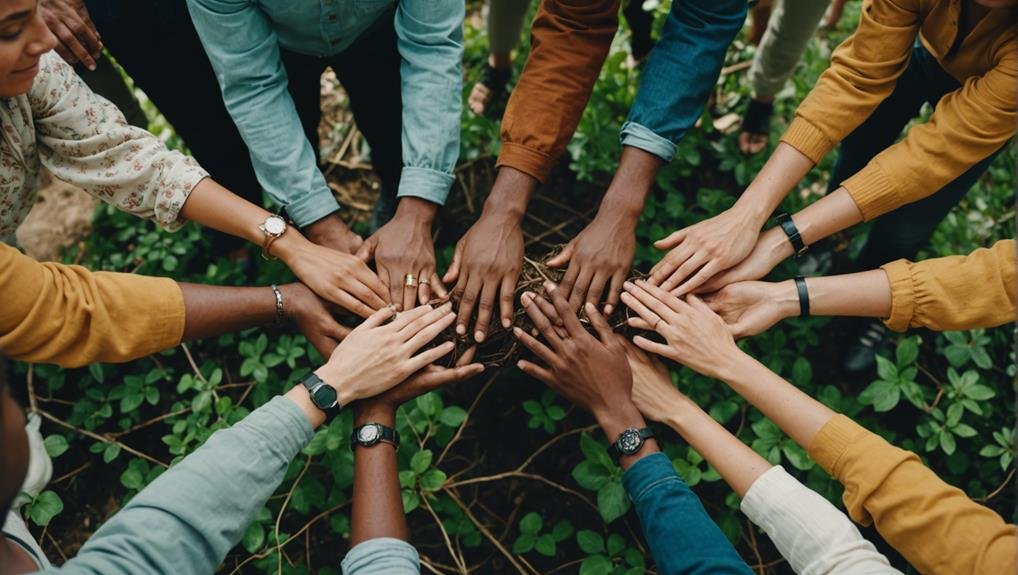We are transforming behavior change for thousands by tapping into the power of community and shared identity. By directly involving communities and ensuring their active participation, we foster a sense of shared responsibility and dedication to healthier habits.
Dr. Ernst's initiative, which includes over 2,000 volunteers, demonstrates how effective peer-to-peer education can be in spreading knowledge and encouraging lasting behavior changes. By focusing on group identity, common goals, and support systems, we align new practices with existing cultural norms, making them sustainable.
This community-driven approach has proven successful in places like Mozambique and Cambodia, empowering communities worldwide to take charge of their health. Learn how these methods lead to significant improvements.
Changing Habits at Scale
When we aim to change habits on a large scale, it's crucial to use the power of community involvement and shared identity.
Engaging the community directly ensures that people feel invested in the change. For example, Dr. Ernst recruited over 2,000 volunteers to show how effective community engagement can be. Each staff member trained groups of volunteers who then visited households, spreading knowledge and encouraging action.
Social influence was key—when volunteers shared information and modeled behaviors, it motivated others to do the same. This peer-to-peer education method not only spread information efficiently but also built a sense of shared responsibility and commitment to healthier habits among community members.
The Role of Group Identity
Group identity significantly shapes how we act and helps create long-term changes. When we join a group, our personal identity is shaped by the group's collective behavior. This shared identity can greatly influence our habits and beliefs.
For example, in Mozambique, communities adopted shared health practices, making it easier for individuals to follow and maintain these behaviors. If a behavior becomes the norm within a group, it's more likely to be sustained.
Shaping Group Behaviors

To shape group behaviors effectively, you need to understand what drives collective action. Recognizing the roles of community engagement and cultural influence is essential.
To shape group behaviors, focus on:
- Shared Goals: Set common objectives that everyone in the group can support. For example, if you're part of a community cleanup effort, make the goal to collect 500 pounds of trash in a month. This gives everyone a clear target.
- Role Models: Highlight and promote individuals who demonstrate the desired behaviors. If you want to encourage recycling, showcase members of the community who regularly recycle and explain how their actions benefit everyone.
- Communication: Make sure your messaging is clear and consistent. Use simple language and repeat key points often. For instance, if you're promoting a health initiative, regularly share tips and updates through social media, newsletters, and community meetings.
- Support Systems: Build networks that offer encouragement and accountability. Create groups or buddy systems where members can check in with each other. In a fitness program, for example, having a workout buddy can motivate people to stick with their routines.
- Cultural Norms: Align new behaviors with existing cultural values and practices. If your community values sustainability, frame new initiatives like carpooling or using reusable bags as ways to uphold these values.
Replicating Success Globally
Building on successful local projects, we aim to replicate community-driven health initiatives globally to create lasting change. Our approach focuses on global expansion by empowering communities through proven methods like the Care Groups system. By training local volunteers to share health knowledge, we foster community empowerment, ensuring that each region can manage health issues independently. This model has already shown great results in Mozambique and Cambodia, demonstrating its adaptability and effectiveness. As we expand these efforts, we'll leverage community identity and shared behaviors to transform health norms worldwide. Replicating these initiatives globally will help us tackle public health challenges efficiently, making sustainable health improvements a reality for diverse populations.
Here's why this matters: local volunteers trained through the Care Groups system can address health issues specific to their communities. This not only improves health outcomes but also builds trust and ensures long-term sustainability. For example, in Mozambique, trained volunteers helped reduce child malnutrition rates by educating mothers on nutrition and hygiene practices. Similarly, in Cambodia, community health workers provided essential maternal care, significantly lowering maternal mortality rates.
By scaling this model, we can create a ripple effect, where improved health practices in one community inspire neighboring regions to adopt similar initiatives. This approach ensures that health improvements aren't just temporary fixes but become ingrained in the community's way of life.
This global replication strategy, supported by local empowerment, is key to addressing public health challenges efficiently and sustainably, ultimately leading to healthier populations worldwide.
Lasting Community Impact

Creating Lasting Community Impact
True community impact happens when new health practices become part of daily life. Sustainable engagement and community-driven initiatives are essential for this transformation. By fostering a sense of ownership and identity, communities can maintain lasting changes.
Here are some key elements:
- Volunteer Empowerment: Encouraging local volunteers to lead initiatives helps build trust and ensures the community feels responsible for the changes.
- Regular Training: Providing ongoing education keeps everyone informed and up-to-date on best practices.
- Support Networks: Forming groups where people can share their progress and challenges fosters a sense of community and mutual support.
- Cultural Integration: Making sure new practices fit with local customs ensures they're more likely to be adopted and maintained.
- Continuous Feedback: Collecting input from the community helps refine and improve approaches, making them more effective.
For example, in a project to improve local nutrition, volunteers could lead workshops on healthy cooking. Regular training sessions could update these volunteers on the latest nutritional advice, while support networks could allow them to share their successes and troubleshoot challenges. Ensuring the recipes align with local tastes and customs would make the new practices more appealing, and continuous feedback from the community could help refine these efforts for even better results.
Conclusion
We've done something incredible together: we've changed health behaviors on a large scale.
By using the strength of community and shared identity, we didn't just introduce new habits; we made them part of the culture.
Our work in Mozambique and other places shows that with teamwork and good support, lasting change is possible.
When communities come together, they can tackle health problems and build a healthier future for everyone.
